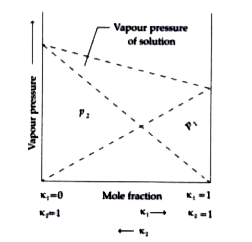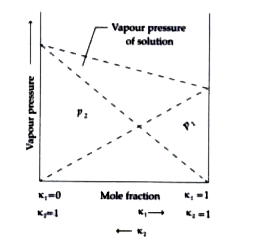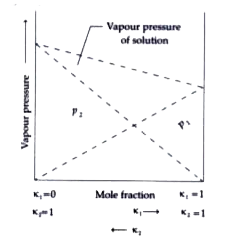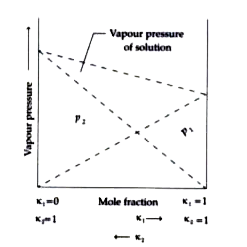Identify the law which is stated as:
For any solution, the partial vapour pressure of each volatile component in the solution is directly proportional to its mole fraction.
Henry’s law
Raoult’s law
Dalton’s law
Gay-Lussac's Law
To solve the question, we need to identify the law that states: "For any solution, the partial vapor pressure of each volatile component in the solution is directly proportional to its mole fraction."
1. Understanding the Statement: The statement refers to the relationship between the partial vapor pressure of volatile components in a solution and their mole fractions. This indicates a proportional relationship.
2. Identifying the Law: The law that describes this relationship is Raoult's Law. According to Raoult's Law, the partial vapor pressure (P_A) of a component A in a solution is directly proportional to its mole fraction (X_A) in that solution. Mathematically, it can be expressed as:
PA=P0A⋅XA
where P0A is the vapor pressure of the pure component A.
3. Conclusion: Based on the above understanding, we can conclude that the law being referred to in the question is Raoult's Law.
Final Answer:
The law stated in the question is Raoult's Law.
---
PA=P0A⋅XA
where P0A is the vapor pressure of the pure component A.
The law stated in the question is Raoult's Law.
Topper's Solved these Questions
- SAMPLE PAPER 2022BOOK - CBSE MODEL PAPERCHAPTER - SAMPLE PAPER 2022EXERCISE - SECTION B
24 Videos
- SAMPLE PAPER 2022BOOK - CBSE MODEL PAPERCHAPTER - SAMPLE PAPER 2022EXERCISE - SECTION C
6 Videos
- QUESTION BANK 2021BOOK - CBSE MODEL PAPERCHAPTER - QUESTION BANK 2021EXERCISE - Multiple Choice Questions
72 Videos
- SAMPLE PAPER 2022 TERM IIBOOK - CBSE MODEL PAPERCHAPTER - SAMPLE PAPER 2022 TERM IIEXERCISE - SECTION-C
5 Videos
Similar Questions
Read the passage given below and answer the following questions :
Raoult's law states that for a solution of volatile liquids, the partial vapour pressure of each component of the solution is directly proportional to its mole fraction present in solution. Dalton's law of partial pressure states that the total pressure Ptotal over the solution phase in the container will be the sum of the partial pressures of the components of the solution and is given as:
Ptotal= P1+ P2

A solution of two liquids boils at a temperature more than the boiling point of either of them. What type of deviation will be shown by the solution formed in terms of Raoult' s law ?
View SolutionRead the passage given below and answer the following questions :
Raoult's law states that for a solution of volatile liquids, the partial vapour pressure of each component of the solution is directly proportional to its mole fraction present in solution. Dalton's law of partial pressure states that the total pressure Ptotal over the solution phase in the container will be the sum of the partial pressures of the components of the solution and is given as:
Ptotal= P1+ P2

In comparison to a 0.01 M solution of glucose, the depression in freezing point of a 0.01 M MgCl2 solution is _ ___
View Solution
Knowledge Check
For a solution of volatile liquids the partial vapour pressure of each component in solution is directly proportional to
AMolarityBMole fractionCMolalityDNormalityRead the passage given below and answer the following questions :
Raoult's law states that for a solution of volatile liquids, the partial vapour pressure of each component of the solution is directly proportional to its mole fraction present in solution. Dalton's law of partial pressure states that the total pressure Ptotal over the solution phase in the container will be the sum of the partial pressures of the components of the solution and is given as:
Ptotal= P1+ P2

Which of the following aqueous solutions should have the highest boiling point ?A1.0 M NaOHB1.0 M Na2S04C1.0 M NH4NO3D1.0 M KNO3Read the passage given below and answer the following questions :
Raoult's law states that for a solution of volatile liquids, the partial vapour pressure of each component of the solution is directly proportional to its mole fraction present in solution. Dalton's law of partial pressure states that the total pressure Ptotal over the solution phase in the container will be the sum of the partial pressures of the components of the solution and is given as:
Ptotal= P1+ P2

What type of deviation from Raoult's law does the above graph represent ?AFirst positive then negativeBNegative deviationCPositive deviationDFirst negative then positive
______ states that for a solution of volatile liquids, the partial vapour pressure of each component of the solution is directly proportional to its mole fraction present in solution.
View Solution________ states that for a solution of volatile liquids, the partial vapour pressure of each component of the solution is directly proportional to its mole fraction present in solution
View SolutionPartial pressure of a solution component is directly proportional to its mole fraction. This is known as
View SolutionPartial pressure of a solution component is directly proportional to its mole fraction. This statement is known as
View SolutionIf Raoult's law is obeyed, the vapour pressure of the solvent in a solution is directly proportional to
View Solution
